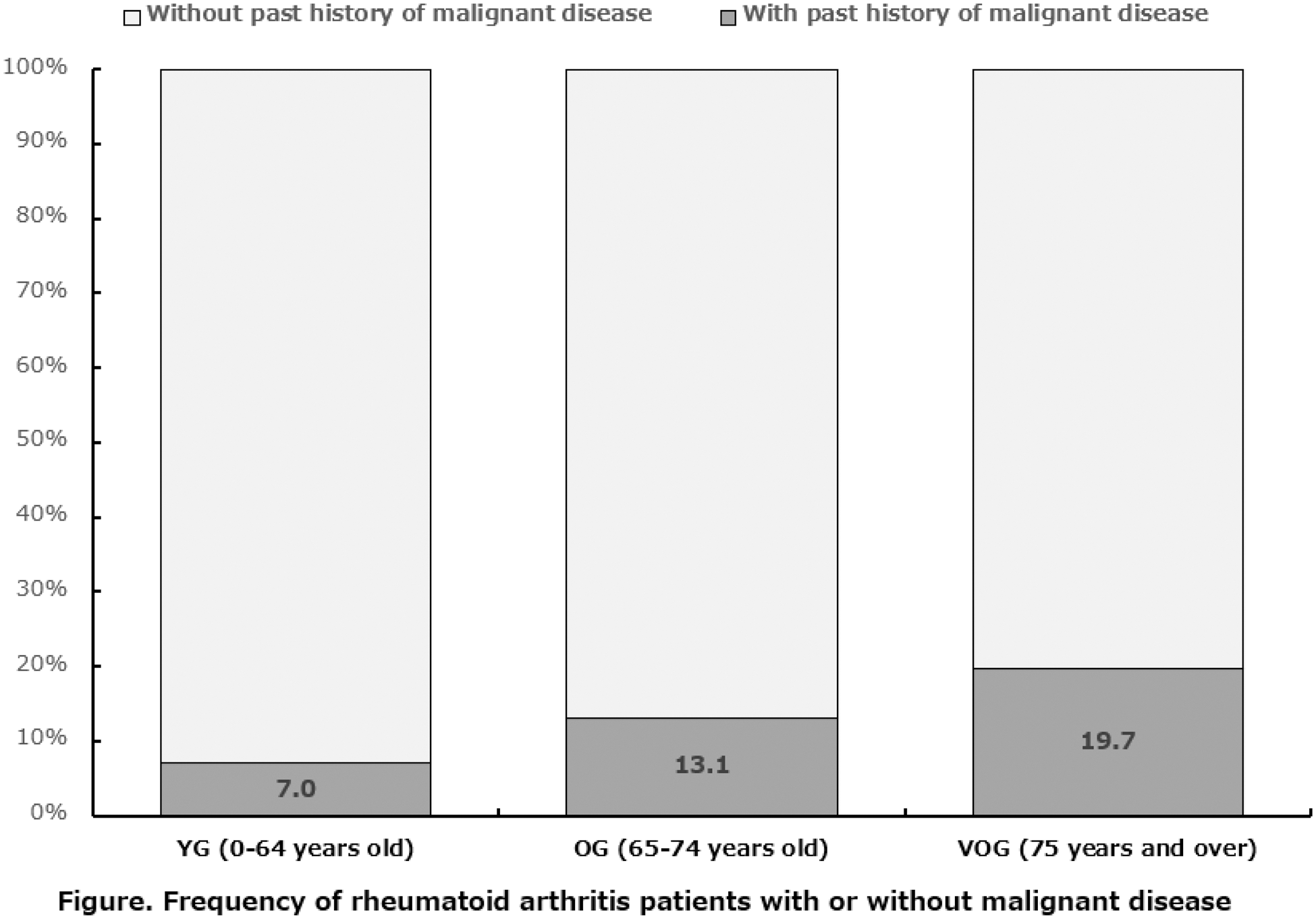

Background: Strategies for the treatment of rheumatoid arthritis (RA) has progressed considerably alongside strategies for treatment of malignant diseases has also progressed. Clinical practice seems to have provided ever increasing opportunities to encounter RA patients with a history of malignant disease. In line with this, evidence for the use of medication in RA patients with a history of malignant disease has been, and clinicians often experience difficulty in selecting treatment. “EULAR Points to Consider on the initiation of targeted therapies in patients with inflammatory arthritis and a history of cancer” was presented at EULAR2024 and is expected to serve as a guide for clinicians. However, data on patients with RA and a history of malignant disease.
Objectives: The current study aimed to investigate the frequency, patient background, and drug treatment of RA patients with a history of malignant disease.
Methods: A cross-sectional survey of clinical data from 960 RA patients treated at our department was conducted. Patients were divided into three age groups: 0–64 years old (YG: n = 315), 65–74 years old (OG: n = 260), and 75 years old and over (VOG: n = 385). The frequency and most common type of malignant diseases were investigated according to age group. Next, patient backgrounds of RA patients with and without a history of malignant disease were compared according to age group. The Cochran–Armitage test, Mann–Whitney U test, and Chi-Square test were used for statistical analyses, with p <0.05 indicating statistical significance.
Results: The characteristics of the included patients [YG/OG/VOG] are as follows: mean age (years) [53.0/70.3/80.7], % female [77.5/73.8/73.8], RF positivity (%) [80.7/75.7/73.3], ACPA positivity (%) [80.1/75.5/69.2], prescribed MTX (%) [59.4/53.5/41.0], prescribed glucocorticoids (%) [5.1/7.3/9.9], prescribed bDMARD or tsDMARD (%) [45.4/43.8/38.4], and mean SDAI [3.3/3.1/4.0]. The frequency of patients who had a history of malignant diseases was 7.0%, 13.1%, and 19.7% in the YG, OG, and VOG, respectively (p = 0.027, Figure 1). The three most common malignant diseases were as follows: (1) uterine cancer, (2) breast cancer, and (3) thyroid cancer, prostate cancer, colon cancer, and lung cancer in the YG; (1) breast cancer, (2) colon cancer, and (3) stomach cancer in the OG; (1) colon cancer, (2) lung cancer, and (3) breast cancer in the VOG. In the YG group, patients with a history of malignant disease had significantly higher DAS28-ESR [3.2 vs. 2.6] and higher CRP levels [0.45 vs. 0.41 mg/dL] and lower rates of bDMARD or tsDMARD use [13.6% vs. 47.8%] than did patients without a history of malignant disease. In the OG, no significant differences in patient background were observed between patients with and without a history of malignant disease. In the VOG, patients with a history of malignant disease had a significant lower proportion of women [64.5% vs. 76.1 %] and a lower rate of MTX use [30.3% vs. 43.7%] than did patients without a history of malignant disease. The bDMARDs or tsDMARDs administered to patients with a history of malignant disease were TNF inhibitors in 25 cases (59.6%), abatacept in 8 cases (19.0%), IL-6 inhibitors in 6 cases (14.3%), and JAK inhibitors in 3 cases (7.1%).
Conclusion: The proportion of patients with a history of malignancy increased with age. A history of malignancy was associated with lower rates of bDMARD or tsDMARD use and worsening disease activity in the YG, but not in the OG or VOG. TNF inhibitors were the most commonly used bDMARDs or tsDMARDs in patients with a history of malignancy.
REFERENCES: NIL.

Acknowledgements: NIL.
Disclosure of Interests: None declared.
© The Authors 2025. This abstract is an open access article published in Annals of Rheumatic Diseases under the CC BY-NC-ND license (